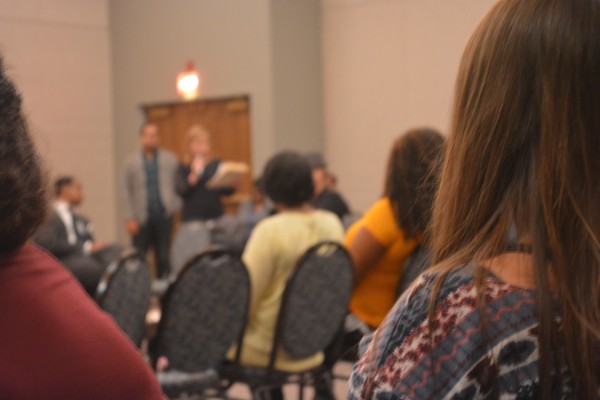College of William and Mary President Taylor Reveley established the Task Force on Race and Race Relations in spring 2015 in response to racially insensitive parties and social media postings on campus, as well as to address larger, racially-charged problems. The Task Force held a community forum for undergraduate students to share their experiences and suggestions Wednesday, Nov. 11.
College of William and Mary President Taylor Reveley established the Task Force on Race and Race Relations in spring 2015 in response to racially insensitive parties and social media postings on campus, as well as to address larger, racially-charged problems. The Task Force held a community forum for undergraduate students to share their experiences and suggestions Wednesday, Nov. 11.
According to Chief Diversity Officer and Task Force Chair Chon Glover M.Ed. ’99, Ed.D. ’06, the Task Force was charged with investigating multiple topics.
“Once appointing this Task Force, the president’s charge was to explore these three areas, racial climate, recruitment and retention of diverse faculty, education and training, and recording and responding to incidents of racial bias,” Glover said. “At this point, we are ready to hear from you, the campus community, as your feedback is very important.”
Following these forums, the Task Force will brief the president in the spring on their findings and suggestions for solutions to the problems that have been brought to their attention.
Students in attendance were asked to break up into smaller groups that were each assigned a member of the Task Force as a discussion facilitator. For 30 minutes, the groups discussed three questions: how they perceived the campus climate in regards to race and race relations, what changes would they like to see regarding the campus climate, and how would they go about making those changes.
“When we talk about a need for a more diverse pool of faculty, staff, and students on this campus, we are talking about a need to ensure that we are adequately preparing all of our students for existence in a multicultural world — a world that does not look like William and Mary in terms of racial composition,” Ebony Lambert ’16 said in an email.
In these discussions, students mentioned the lack of diversity in the College’s faculty, the lack of administrative response to national, racially-charged events like those at the University of Missouri, the negativity and racism seen on social media, and the lack of faculty support for students of color within the classroom environment.
Ebony Lambert ’16, a member of the Task Force, explained why she thought having a diverse faculty is important.
“When we talk about a need for a more diverse pool of faculty, staff, and students on this campus, we are talking about a need to ensure that we are adequately preparing all of our students for existence in a multicultural world — a world that does not look like William and Mary in terms of racial composition,” Ebony Lambert ’16 said in an email. “When we talk about a need for diversity, we are speaking of a need to intimately acquaint our students with perspectives, lifestyles, and cultures that differ from their own, in the interest of not only helping them to become more experienced and more well-rounded, but also help them to become more open and compassionate human beings. When we speak of a need for diversity we speak of the necessity of understanding just how crippling xenophobia and lack of exposure to diverse peoples have been in our past, if we are to create or pave a better future.”
Following the small group discussions, each of the Task Force members shared their group’s discussion with the larger audience. William and Mary Chief of Police Deb Cheesebro focused on her group’s discussion of a lack of school response, as well as the discussion of possible solutions.
“We did talk about a lack of response from the school, just generally speaking, in a timely fashion for any event that could be impacting our students and they could be hurting and need to talk about it, but the school does not have a timely response or a way of facilitating that conversation,” Cheesebro said. “We talked about ‘One Tribe, One Family’ being sold to everyone and then the realization a year or so later that they do not feel that they are part of the family.”
In terms of solutions, students and facilitators proposed and discussed the possibilities of adding a required online curriculum similar to Alcohol Edu that would focus on cultural diversity. Additionally, they proposed extending orientation for freshmen to include more information on racism and discrimination with a focus on extending the conversation beyond the first year.
“We talked about ‘One Tribe, One Family’ being sold to everyone and then the realization a year or so later that they do not feel that they are part of the family,” Cheesebro said.
Many students also shared their experiences of facing negativity and hatred based on their race and shared how they viewed certain social media apps, such as the Facebook page “Overheard at William and Mary” and Yik Yak, as contributing to that open racism. Board of Visitors member and Task Force member Kendrick Ashton, Jr. ’98 shared his group’s discussion of Yik Yak and how to deal with problems that arise from social media.
“There was a meaningful discussion around the impact Yik Yak had on the climate,” Ashton said. “Some folks thought that it was quite negative and folks felt like it was just a medium for views to be expressed in negative forms.”
For students like Lambert, the Task Force is part of a transformational measure that can improve the quality of the racial climate on campus.
Students will have another opportunity to share their experiences or propose solutions in the second student forum Nov. 17 in Blow Hall at 7:00 p.m.

